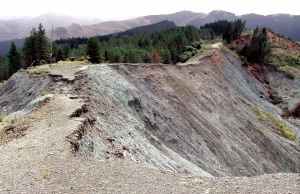Terrestrial WG 2009: Difference between revisions
No edit summary |
No edit summary |
||
| Line 11: | Line 11: | ||
==== Introduction ==== | ==== Introduction ==== | ||
The Terrestrial Working Group deals with weathering, hillslope, fluvial, glacial, aeolian, lacustrial challenges. | |||
==== Participants ==== | ==== Participants ==== | ||
If you are interested to join this meeting, please contact the Terrestrial WG Chair, Greg Tucker ( | If you are interested to join this meeting, please contact the Terrestrial WG Chair, Greg Tucker (gtucker@cires.colorado.edu). Registration deadline is January 16, 2009. | ||
Personal invitations have been sent to specific CSDMS members with expertise in these areas to contribute to the discussion and planning of short- and long-term goals. | Personal invitations have been sent to specific CSDMS members with expertise in these areas to contribute to the discussion and planning of short- and long-term goals. | ||
| Line 19: | Line 20: | ||
==== Circulars and Program==== | ==== Circulars and Program==== | ||
The agenda for this meeting of the Terrestrial Working Group is two-fold. The first aim is to bring the working group up to speed on the progress that the I.F. team has made in developing methods and protocols for coupling modules, as well as to provide an overview of how to modify your own code so that it can be integrated into the CSDMS framework. The second aim is to make progress on three fronts: (1) completing the process of “domain and model scoping” that we began at last year’s meeting, possibly leading to a review paper; (2) identifying, developing, adding, and linking model components (including outlining methods for handling issues such as moving boundaries); and (3) identifying existing data sets, and criteria for future data sets, that can be used for testing models and providing proof-of-concept applications. | The agenda for this meeting of the Terrestrial Working Group is two-fold. The first aim is to bring the working group up to speed on the progress that the I.F. team has made in developing methods and protocols for coupling modules, as well as to provide an overview of how to modify your own code so that it can be integrated into the CSDMS framework. The second aim is to make progress on three fronts: (1) completing the process of “domain and model scoping” that we began at last year’s meeting, possibly leading to a review paper; (2) identifying, developing, adding, and linking model components (including outlining methods for handling issues such as moving boundaries); and (3) identifying existing data sets, and criteria for future data sets, that can be used for testing models and providing proof-of-concept applications. | ||
The Terrestrial Working Group will meet for 2 days. | |||
Please revisit this website for a detailed agenda. | |||
Revision as of 15:22, 13 November 2008
CSDMS Hydrology Focus Research Group meeting , February 2-4, 2009

| Date: February 2-3, 2009 |
| Location: University of Colorado at Boulder (CO), USA |
| Host: CSDMS |
Introduction
The Terrestrial Working Group deals with weathering, hillslope, fluvial, glacial, aeolian, lacustrial challenges.
Participants
If you are interested to join this meeting, please contact the Terrestrial WG Chair, Greg Tucker (gtucker@cires.colorado.edu). Registration deadline is January 16, 2009.
Personal invitations have been sent to specific CSDMS members with expertise in these areas to contribute to the discussion and planning of short- and long-term goals.
Circulars and Program
The agenda for this meeting of the Terrestrial Working Group is two-fold. The first aim is to bring the working group up to speed on the progress that the I.F. team has made in developing methods and protocols for coupling modules, as well as to provide an overview of how to modify your own code so that it can be integrated into the CSDMS framework. The second aim is to make progress on three fronts: (1) completing the process of “domain and model scoping” that we began at last year’s meeting, possibly leading to a review paper; (2) identifying, developing, adding, and linking model components (including outlining methods for handling issues such as moving boundaries); and (3) identifying existing data sets, and criteria for future data sets, that can be used for testing models and providing proof-of-concept applications.
The Terrestrial Working Group will meet for 2 days. Please revisit this website for a detailed agenda.
